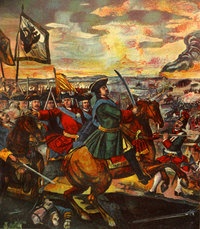Battle of Poltava
|
|
| Missing image Marten's_Poltava.jpg The Battle of Poltava as painted by Denis Martens the Younger in 1726. | |||||||||||||||||
| Battle of Poltava | |||||||||||||||||
|---|---|---|---|---|---|---|---|---|---|---|---|---|---|---|---|---|---|
| Conflict | Great Northern War | ||||||||||||||||
| Date | June 28, 1709 | ||||||||||||||||
| Place | Poltava, eastern Ukraine | ||||||||||||||||
| Result | Decisive Russian victory | ||||||||||||||||
| |||||||||||||||||
The Battle of Poltava (or Pultowa) was a battle between the armies of Peter I of Russia and Charles XII of Sweden on June 28 (new style July 8) 1709, the most famous of the battles of the Great Northern War. The decisive victory of the Russians is said to have ended Sweden's role as a major power in Europe.
After early victories in 1700 knocked both Denmark and Russia out of the war, Charles was unable to bring the war to conclusion, and took until 1708 to deal with the remaining combatant, Saxony-Poland. During this time Peter rebuilt his army in modern form, basing it primarily on infantry trained to properly use their firearms. He then achieved a stunning victory in Livonia, and established Saint Petersburg there. Incensed, Charles was prompted to make the fatal decision to attack the Russian heartland with an assault on Moscow.
Charles had marched into Russia in 1708 at the head of a large army, but the Russian forces refused direct combat, and instead adopted their standard form of warfare against an invader, scorched earth. The summer was cold and wet, and with supplies difficult to come by on the ground, Charles relied on a relief column that was bringing with it enough food to maintain the army for lengthy periods. The relief column, under Lewenhaupt, consisted of 11,000 men, 16 cannon, a herd of cattle and thousands of wagons, normally slow-moving in the best of conditions and now slowed to a crawl by the condition of the roads.
With no direct communications between the two forces, Charles waited as long as he could for Lewenhaupt to arrive. At one point they were only 80 miles apart, but this being unknown to him, Charles gave up, struck camp, and turned south to Ukraine in search of grain and better weather. Ukraine, under the command of Mazepa, had been in discussions with Charles for some time, and at this point officially allied herself to the Swedes in order to gain independence from Russia.
Lewenhaupt followed south and was attacked while crossing a river near a small village that gave name to the Battle of Lesnaya, but were amazed to find the new Russian army gave them a serious fight. Lewenhaupt decided to rejoin Charles with all speed, to do so he abandoned the cannon, cattle and most of the food, driving the soldiers to mutiny. Stealing all the alcohol, they got drunk, and Lewenhaupt had to leave about 1,000 men drunk in the woods. By the time they finally reached Charles and the main force in the winter, they were only about 6,000 men and had no luggage.
In the spring Charles resumed his advance, but by this time his army had been reduced in force by about one-third due to starvation, frostbite and other effects of the weather. The wet weather had also seriously depleated their supplies of gunpowder, notably for their cannon which were essentially out of action. Their first stop was to lay siege to the fort of Poltava on the Vorskla River in Ukraine. Peter had already organized a huge force to protect it, and soon arrived and set up a counter-siege line, trapping the Swedish forces between the fort and the Russian lines.
When the battle opened, Charles had about 19,000-20,000 men, while Peter commanded about 42,000-45,000. To make matters worse, Charles was wounded during the siege and had to turn over command to field marshal Carl Gustav Rehnskiöld. Nevertheless he planned to break the Russian lines and escape to the north.
The battle began before dawn at 3:45 am, with the Swedes advancing against the Russian fortified lines. At first, the battle started off in traditional fashion, with the better trained Swedes pressing in on their left flank and center, overunning a few Russian defensive redoubts. A victory appeared in the making once again, but this was not to be. By dawn, the weather was already very hot and humid with the rising sun obscured by smoke from cannon and musket fire. Peter had considerably greater numbers of infantry, and while holding off the Swedish forces with cannon fire, he was able to organize a huge group of about 25,000 re-enforcements in the center which he deployed outside of his fortified camp at around 9:00 am. Soon the Swedish advance faltered, and poor communications between their lines led to a retreat by 11:00 am. The Swedes made for the Dnieper River but were pursued by the Russians, and were forced to surrender three days later on July 1.
Several thousand prisoners were taken, many whom were put to work building the new city of St. Petersburg. Charles managed to escape with about 1,500 men to Moldova, then controlled by the Ottoman Empire, and spent two years in exile here before being able to return to Sweden.
Why Charles chose to continue with the hopeless offensive after the disastrous winter is a mystery. Nevertheless the battle was not the end of the Great Northern War, which continued for another twelve years. In the end it was the buildup of naval power at St. Petersburg that finally knocked Sweden out of the war.
Swedish Officers in the Battle of Poltava
- Anders Örbom (1675-1740), Captain
Books
- Englund, Peter; The Battle That Shook Europe: Poltava and the Birth of the Russian Empire
External links
- Battle of Poltava (http://www.encyclopediaofukraine.com/pages/P/O/PoltavaBattleof.htm)
- The Decline of the Great Power: The Battle of Poltava (http://www.utb.boras.se/uk/se/projekt/history/articles/decline/decline5.htm) (also used as a reference)da:Slaget ved Poltava
de:Schlacht bei Poltawa fr:bataille de Poltava nl:Slag bij Poltava ru:Полтавская битва sv:Slaget vid Poltava

